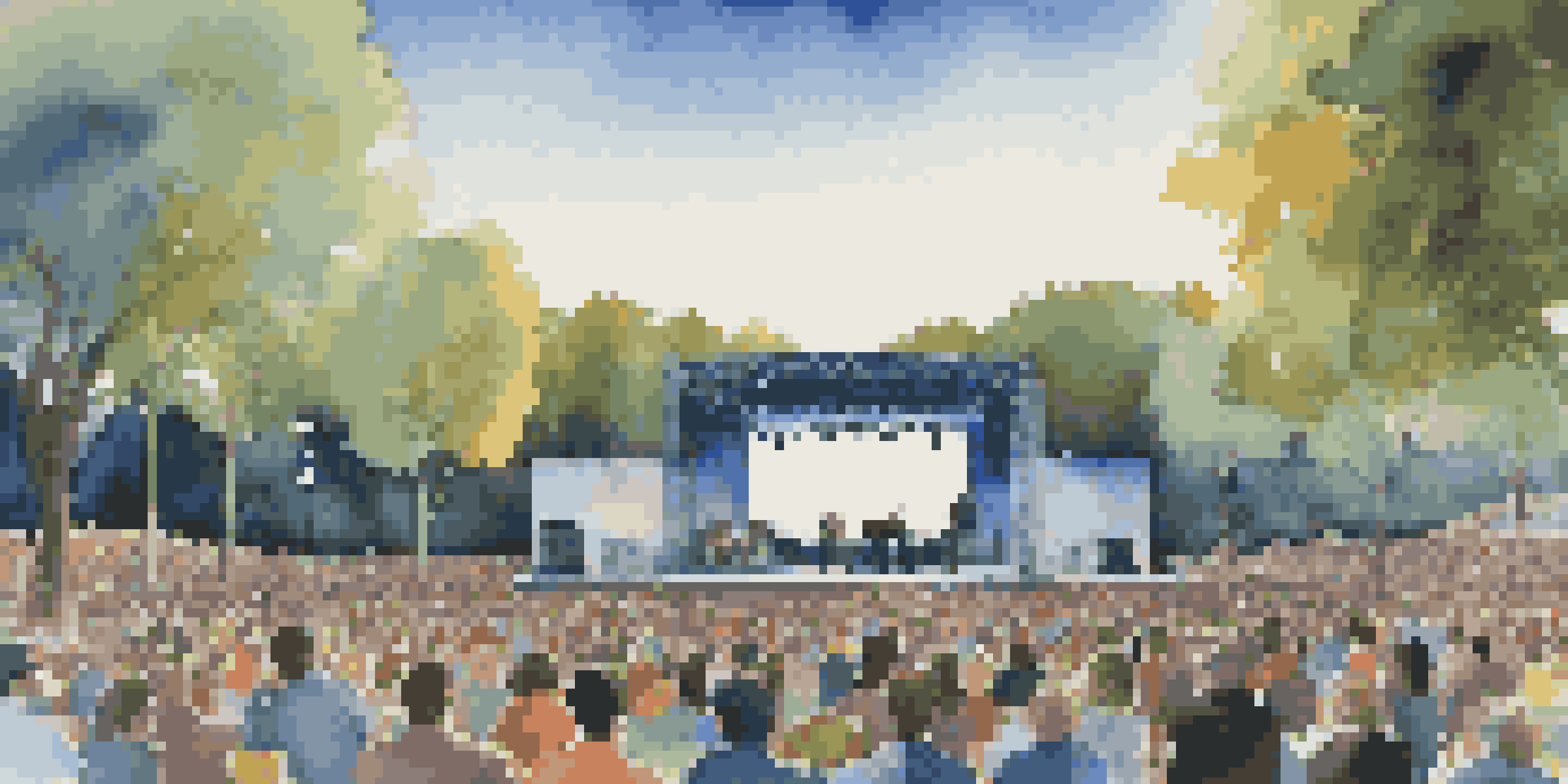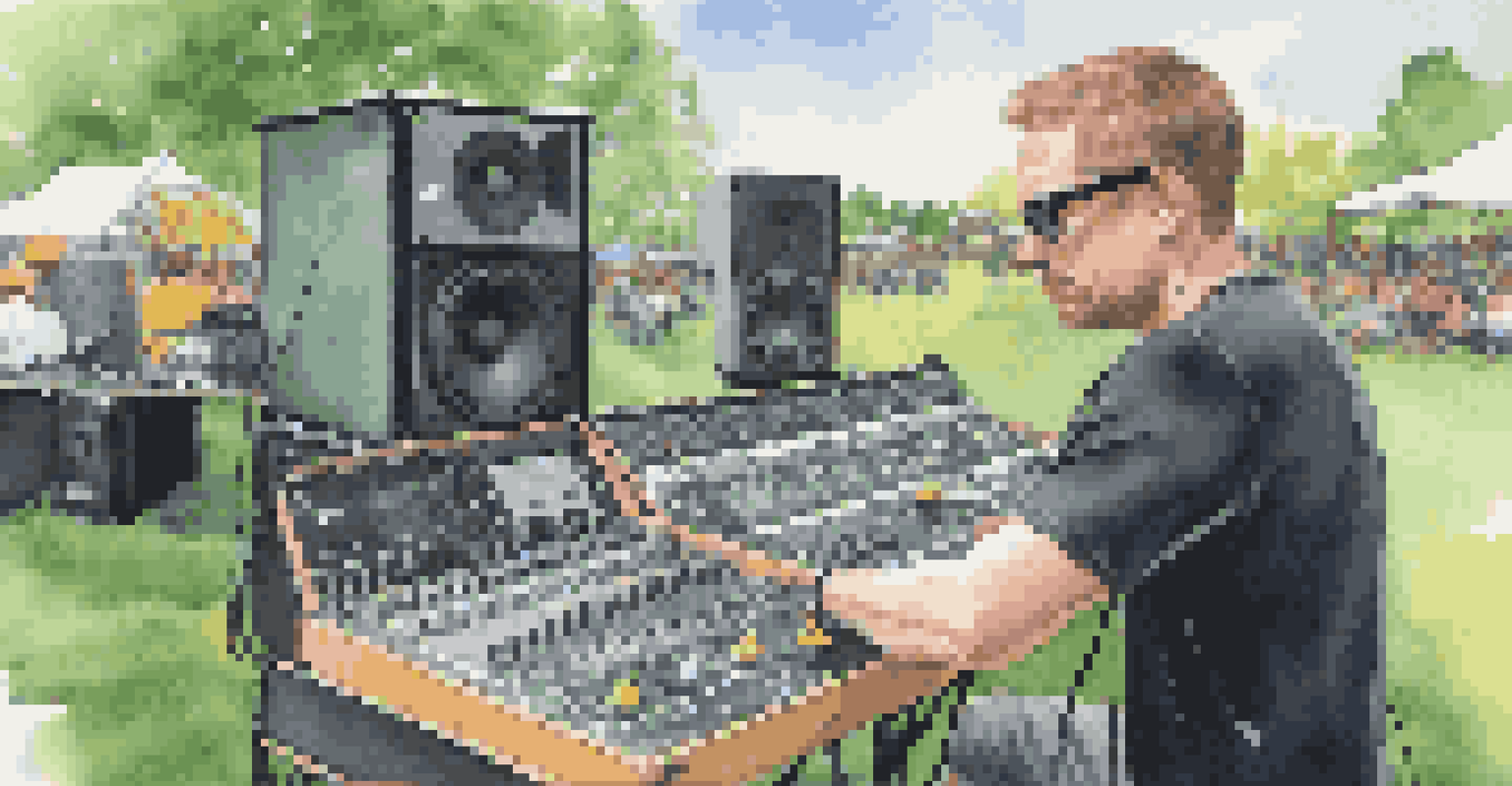The Challenges of Outdoor Live Sound Engineering

Understanding the Acoustic Environment Outdoors
Outdoor venues present unique acoustic challenges that differ significantly from indoor settings. Factors like wind, temperature, and humidity can affect sound propagation, creating a dynamic environment that constantly shifts. For instance, a gentle breeze can carry sound away from the audience, leading to uneven listening experiences.
Sound is a very complex phenomenon that can be affected by a myriad of variables, especially outdoors where nature itself becomes part of the sound system.
Acoustic reflections from nearby structures, such as buildings or natural features, can also disrupt the clarity of sound. Engineers must take these variables into account when planning the placement of speakers and microphones. Understanding the local geography and environmental conditions is crucial to achieving optimal sound quality.
To navigate these challenges, sound engineers often conduct site surveys to assess the acoustic landscape before the event. This proactive approach allows them to anticipate potential issues and devise strategies to mitigate them, ensuring that audiences enjoy a clear and engaging performance.
Dealing with Weather Variability and Uncertainty
Weather can be unpredictable, and this unpredictability poses a significant challenge for outdoor live sound engineering. Rain, high winds, and extreme temperatures can not only affect equipment functionality but also impact sound quality. For example, rain can muffle sound and cause electrical issues with audio gear, leading to potential failures during a performance.

Engineers must be prepared for sudden weather changes, often having contingency plans in place. This might include investing in weather-resistant equipment or having backup systems ready to roll out. Additionally, understanding how weather conditions affect sound waves helps engineers adjust their setups accordingly.
Outdoor Acoustics Are Challenging
Outdoor venues face unique acoustic issues due to environmental factors like wind and reflections from nearby structures.
To effectively handle these uncertainties, good communication with event organizers and real-time monitoring of weather forecasts are essential. By staying alert to changing conditions, sound engineers can make quick decisions to protect both their equipment and the audience's experience.
Managing Equipment Logistics and Setup Challenges
Setting up sound equipment for outdoor events involves logistical challenges that require careful planning. Transporting heavy gear to remote or uneven locations can be labor-intensive, often needing specialized equipment like carts or trailers. Moreover, the setup must be completed efficiently to meet tight event schedules, adding to the pressure.
Good communication is the bridge between confusion and clarity.
Engineers must also consider power supply options, as outdoor venues often lack reliable electricity sources. This can necessitate the use of generators, which come with their own set of challenges, such as noise and fuel management. Ensuring that all equipment is properly powered and ready to go is vital for seamless performances.
Additionally, managing cables and connections in outdoor settings can be tricky, especially if the terrain is rugged or wet. Engineers employ various techniques, like using cable ramps or securing cables with tape, to prevent tripping hazards and maintain safety. A well-thought-out equipment logistics plan is key to a successful outdoor event.
Addressing Sound Quality Issues in Open Spaces
One of the primary concerns in outdoor live sound engineering is achieving consistent sound quality across a large audience area. Unlike enclosed venues that reflect sound, outdoor spaces can lead to sound dispersion and loss of clarity. Engineers must carefully consider speaker placement and the type of sound system used to combat these issues.
Utilizing line arrays or strategically positioned speakers can help distribute sound evenly throughout the venue. By analyzing the acoustics and audience layout, sound engineers can optimize the sound system for a better listening experience. This involves not only technical knowledge but also creativity in solving unique challenges.
Weather Impacts Sound Engineering
Unpredictable weather can disrupt equipment functionality and sound quality, necessitating contingency plans for engineers.
Moreover, sound checks are crucial for identifying and addressing potential sound quality issues before the audience arrives. Engineers often spend hours tweaking settings and testing different configurations to ensure that every attendee enjoys the performance equally. This attention to detail is what sets successful outdoor events apart.
Communicating Effectively with Artists and Teams
Good communication is vital for successful outdoor live sound engineering, particularly when working with artists and production teams. Each performer may have specific sound preferences or technical requirements, making it essential for engineers to establish clear lines of communication. This collaboration ensures that everyone is on the same page and helps avoid misunderstandings.
During rehearsals, sound engineers often gather feedback from artists to make necessary adjustments. This process fosters a collaborative environment where artists feel heard and valued, ultimately enhancing the performance. Additionally, regular check-ins throughout the event help maintain a smooth workflow.
Effective communication extends to coordinating with other production staff, such as lighting and staging teams. Synchronization is key in creating a cohesive experience for the audience, and sound engineers play a critical role in this collaborative effort. By fostering strong relationships with all team members, engineers contribute to the overall success of the event.
Safety Considerations for Outdoor Sound Engineering
Safety is a paramount concern when it comes to outdoor live sound engineering. Engineers must ensure that all equipment is set up securely to prevent accidents, especially in outdoor environments where winds can be unpredictable. This includes anchoring speakers and securing cables to minimize trip hazards.
Electrical safety is also critical, as outdoor events often involve the use of generators and power supplies. Ensuring that all equipment is properly grounded and that electrical connections are safe can prevent dangerous situations. Engineers must remain vigilant and proactive in assessing potential risks.
Communication is Key for Success
Effective communication with artists and production teams is essential to ensure a seamless and cohesive performance experience.
Moreover, environmental factors like extreme temperatures can pose health risks to both engineers and artists. Providing adequate hydration and rest areas is essential for maintaining a safe working environment. By prioritizing safety, sound engineers can focus on delivering high-quality performances while protecting everyone involved.
The Importance of Post-Event Evaluation and Learning
After an outdoor event wraps up, conducting a post-event evaluation is crucial for continuous improvement in sound engineering. This process involves gathering feedback from artists, team members, and even the audience to assess what worked well and what could be improved. These insights are invaluable for refining future setups.
Engineers often review recordings from the event to analyze sound quality and identify areas for enhancement. By examining both technical aspects and audience reactions, they can develop strategies to tackle similar challenges in future events. This commitment to learning fosters growth and expertise in the field.

Additionally, sharing experiences and lessons learned with fellow engineers can help build a supportive community. Collaborating and exchanging knowledge ensures that everyone benefits from collective experiences, ultimately advancing the field of outdoor live sound engineering. This spirit of cooperation is what drives the industry forward.